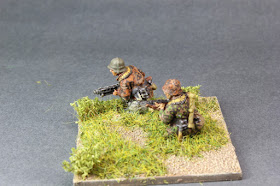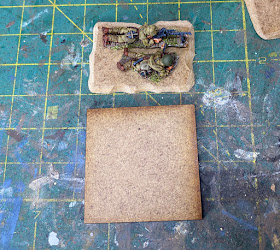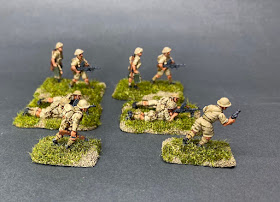Junior leaders were given a 25mm round base while senior leaders went onto larger 20x40mm rectangular bases.
Weapon crews had their figures grouped in twos or threes around their weapon on a 40x40mm square. I like the idea of having a slightly larger base to make it easy to distinguish a LMG gunner from a regular rifleman, but on the other hand I don't want to put a full three or four man LMG team on a single base as that makes it difficult to remove casualties as they occur. I think two figures on a base, comprising the gunner and the loader, is a suitable compromise.
This worked well for most of my figures, but over time a few practical issues have arisen. On the tabletop the larger 40x40 bases have a big footprint for only two figures (effectively taking up the same area as four figures on 20mm round bases). That's created issues when the space in a particular piece of terrain is tight.
In the picture below we have a senior leader, a wounded junior leader, a jump-off-point and LMG crew crowded into the upper level of a building. Throw in a few markers for shock and wounds and it has become a very cluttered space.
Naturally this is less of an issue when the terrain is more open.
Although even then it doesn't take much to overcrowd a particular location (and note how it's not the number of figures in the space, it's the size of the bases).
The other issue has been aesthetic. While a large base can make for an attractive diorama type setting for a light mortar or LMG crew, the actual base itself can be chunky and intrusive. At normal viewing distances this is something you don't really notice, but given I take a lot of close-up photographs for the AARs on the blog it's something that has been starting to bug me.
I've also been guilty of trying to shoehorn figures onto bases that are not well suited to the figure's pose - all in the name of sticking to the basing convention. To be honest I was approaching that whole basing convention with far too much rigidity, for no real purpose other than a slightly irrational desire for some sense of order. After all, I'm the one playing with the figures and while I want to help a new player differentiate between unit types there's no need to be so absolutely rigid.
Nothing brought this home to me more than dealing with prone figures. In this urge to keep everything based in the same manner I'd ended up with figures that were starting to look faintly ridiculous, with legs and arms hanging over the edges. With these British tropical figures below I'd felt I had pushed this to the very edge of an acceptable limit and I was never totally happy.
Recently, when I came to painting some Volksgrenadiers with StG44 assault rifles, there was simply no way the prone figures could be made to fit on a 20mm base. So I decided to break with convention and place them on the 20x40mm rectangles that I used for senior leaders. To avoid confusing these figures with senior leaders I sanded the rectangles into more irregular shapes and bevelled the edges. It was immediately apparent that the larger footprint doesn't come so much from the size of the base as it does from the size of the actual figure. A bigger base doesn't create a bigger footprint, but it certainly makes the prone figures look considerably better on the tabletop.
I really like the way this worked and decided I should go back and rebase all my other prone figures in a similar manner. This then led me to thinking about the footprint each based figure or weapon crew created on the tabletop. As mentioned earlier, I've often found the 40x40mm square bases that I would use for say the gunner and loader of an LMG crew impractical when playing in crowded terrain like buildings or jungle. Which then begged the question, did I really need to have such big bases and could I not achieve the same object of a small diorama but on a base with a smaller footprint?
Rather than experiment buying different sized bases I decided to make use of the many offcuts I have left over from MDF kits. That way I could trial a number of base shapes to find what best suited my needs.
For the two man crews I found a 30x40mm size worked well and oddly enough, having the figures in a more compact area seemed to give them a certain dynamism that they lacked before. In some cases two 20mm scale figures on a 40x40mm base could look a little lost. The German LMG crew below is a good example.
A 30mm base width meant the frontage for those crews became less than two individual figures side by side on 20mm bases, which further reduced the footprint for the team or squad. This in turn led me to question the practicality of senior leaders on a 20x40 base - talk about going down a rabbit hole! If I reduced that size to 20x30 they would still be on rectangular bases to differentiate them from a junior leader but with a smaller footprint.
"In another moment down went Alice after it, never once considering how in the world she was to get out again".
An added bonus was that while making these I could address the aesthetic issue I had with the chunky look of the bases. That could be addressed easily enough by using the same method of sanding and bevelling as I had done for the prone Volksgrenadier. Having settled on the dimensions the MDF pieces were cut to size.
The sanding was done with a Dremel rotary tool. This makes it quick and easy (if a little dusty - best done outside).
The end result was a more natural looking base.
Although the area of each base was smaller I felt they still worked well for the two man crews, like this Japanese LMG gunner and loader.
The base is 25% smaller in area and while that might not seem like a substantial difference I could already see how much more practical this will be on the table. I also think the more naturalistic shape tends to draw attention away from the base and towards the figures.
Having removed figures from their larger bases they were then glued to the new bases.
Their metal bases were blended into the MDF base using Milliput.
They were then textured, painted and flocked in my usual basing style. Below are various Japanese LMG and grenade discharger crews with a couple of senior leaders.
Here are some of my early war British for the Far East, in this case four Bren gun crews and a couple of senior leaders.
The senior leaders work just as well on these smaller bases and are much more practical than the larger bases.
While the weapons crews are made more practical on the smaller bases the most fundamental improvement in appearance can be seen in the prone figures. I don't believe their footprint has increased at all but they look so much better on these larger bases.
The bases are only marginally wider than the 20mm rounds but the overall improvement in appearance is a worthwhile trade off.
I particularly like the way they can work with a prone LMG crew as the third member of the team.
There was one other consideration that came into play and that was I wanted the bases to work with my platoon boards. Going smaller was never going to be an issue for the senior leaders or for the two man teams.
I wasn't thinking about how the prone figures would work but I think this compromise will have to do.
So, the next job is to start applying this to all the other platoons. One could easily imagine I have nothing else to do.....no unpainted figures in the lead pile, no unmade models......
This is a pleasing result and I'm looking forward to getting these on the table and seeing what difference they make.











































Great post giving the chronological story of how your basing developed. I think you've cracked it with your last reiteration. I see your a man after my own heart with the organisation and gadgets. Cheers Greg (Delta Coy Blog)
ReplyDeleteThanks Greg, there are times when I’m not sure whether I have a hobby or an affliction (I will give you one guess which one my wife thinks it is LOL), but I love working all this stuff out and coming up with solutions.
DeleteExcellent post detailing your thought processes and an issue continually faced by a lot of wargamers. Personally I think you have come up with a great solution which is practical as well as looking good.
ReplyDeleteCheers, Richard P
Thanks Richard, I’m glad you think it works.
DeleteI absolutely hated thick mdf bases until I read your blog. Sanding down MDF bases to give an irregular surface (with thin edges) is sheer brilliance! I can only wonder why no-one has thought of this before!
ReplyDeleteThanks Rob, I don’t think I realised quite how much I disliked those thick bases until I got rid of them. It does make such a difference.
DeleteWatch out or the MDF dust - nasty stuff for your lungs.
ReplyDeleteMy 2021 project is CoC in 28mm and I am currently thinking of steel washers for bases but with the multi-figure teams I think I will use your format but Litko .08mm bases or plastic card glued to some thin steel sheet I have.
Thanks Graham and yes, I’m very conscious of the dust issue, I always work outside and wear a mask.
DeleteLove the documentation of the design evolution.
ReplyDeleteI went for plastic poker chips as basing material on the basis that they were inconspicuously thin and could be cut out with scissors.
Once properly prepped (washed & roughened with sandpaper) they accept glued plastic figures quite readily.
I opted for rectangular-ish base shapes (narrower frontage than depth) with the corners trimmed off, as this allows figures to fit into tighter rounded spaces as well as allowing greater compaction of frontage when wishing to maximise fire-power.
I also double-base a few of the rifle grunts for economy of movement,
For prone figures I just trimmed the bases to best fit the figures.
For the leaders I opted to put them on round metal bases (repurposed currency) with white markings painted onto the base to denote rank (1 chevron for JLs, 3 chevrons/pips for SLs)
Thanks. That sounds like you’ve come up with a very workable and practical solution - you’re one step ahead of me there!
DeleteVery interesting account of your basing story. The end results look great. I'll bear your experience in mind as I progress with my own CoC project. The idea of sanding the edges and adding irregularities is genius!
ReplyDeleteNow back to my rebasing of eleven Battalions of French Napoleonics!
Thanks Keith. Sanding the bases is a bit of a chore but I think the results are worth the effort. Good luck with your basing.
DeleteGreat post on the trials of bases. I enjoyed following along your thought process. These all ended up looking really great. Good job. 😀
ReplyDeleteThanks Stew. I thought my original basing ideas were pretty good (at the time) so I thought it worth sharing why I changed my mind. Form should follow function and it’s only once you start using something in a game do you realise how well it performs that intended function. I thought I was a genius until I demonstrated that I wasn’t 😩
DeleteGreat article! I often find the hard corners of a lot of traditional square or rectangular bases to be a visual pain point, and have switched to rounded corners wherever I still use square-ish bases.
ReplyDeleteFor Chain of Command, I too have struggled with weapon team basing, in part because of how different the profile is between prone and standing figures.
Thanks and I think your point about the hard corners of square bases has articulated exactly the issue I have with them.
DeleteI still get blown away by the date of other comments here being a day after my 'today'! I'm not sure whether to hate you or love you as just as I become fat, lazy and all set in my 'kit' you come along with an other idea that blows my mind and I throw stuff out and start again! Your platoon boards were my first introduction to your nastiness in this area, now this! By the way the figures are still 20 mm? Right?
ReplyDeleteHa ha, thanks. I don’t mean to bring you pain, other than to share the pain I have created for myself. All well and good having a great idea, it’s the execution that’s usually the problem. And yes, all the figures are still 20mm (for WWII that is).
DeleteA while back you did up a Greenhouse for scatter alond with it you had a wheelbarrow and some other farm implements. I have been everywhere on line trying to fined a 20 mm wheelbarrow! Where on earth (or was it from somewhere else) did you find it!
DeleteI think those carts were MDF and were made by Blotz, if my memory serves me correctly. Keep in mind that model railways are a great source for this sort of scatter terrain, gaming in 1/72 puts us in line with the most popular scale.
DeleteI've always liked the look of your forces on the table, but this is really going to make everything look better. Terrific work.
ReplyDeleteThanks Carole. I think that’s the key, rather than stick to a basing convention for its own sake I want to base for what works and looks best on the table.
DeleteI mainly game in 28mm for CoC, and I have been using 'pill' bases for prone figures, as like you, I was squeezing prone figures on to rounds (2p pieces), and they were annoying me. It looks like a good solution.
ReplyDeleteI think because certain rule sets require specific basing conventions we have a tendency to stick too rigidly to the concept of ‘standard’ basing even when the rules don’t require it.
DeleteGreat improvement and worth the effort.
ReplyDeleteI wonder why you didn´t base your leaders on round bases. They are easier to identify that way. I use small FOW bases with two figures for my WWII 20mm figurines, with a couple of minis per section in individual smaller bases. I put my leaders in coins, junior leaders on two eurocent coins and senior leaders on five eurocents coins. MMGs and small guns in medium FOW bases. I think that is easier to move figurines based by pairs. Anyway, your minis are great!!
ReplyDeleteHanks. I think the important hing about basing is that there are no rights and wrongs, we do what we think works best for us.
DeleteI was happy to read this entry, I have a really tough time breaking basing dogma, although when I refurbished my Brits and Germans with AB figures. I did stop basing tangling legs on circles. All nicely done.
ReplyDeleteThanks. I don’t know why I allowed myself to get so tied down to basing conventions that were my own creation, especially when you end up with things like dangling legs. Good to see I’m not the only one though!
DeleteTremendous post and great looking bases across the troops.
ReplyDeleteThanks Carlo, I’m really pleased with how these have come out and I’m busy converting my other platoons. I don’t normally find basing much fun but for some reason I’m really enjoying this.
Delete